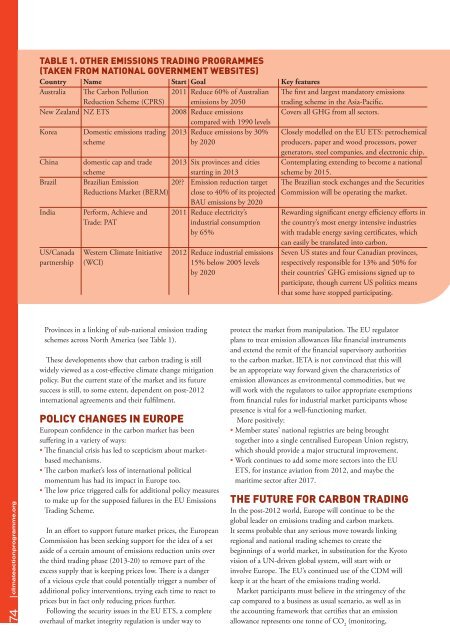Climate Action 2011-2012
You also want an ePaper? Increase the reach of your titles
YUMPU automatically turns print PDFs into web optimized ePapers that Google loves.
Table 1. oTher emissions TradinG ProGrammes<br />
(Taken From naTional GovernmenT websiTes)<br />
Country Name Start Goal Key features<br />
Australia The Carbon Pollution <strong>2011</strong> Reduce 60% of Australian The first and largest mandatory emissions<br />
Reduction Scheme (CPRS) emissions by 2050 trading scheme in the Asia-Pacific.<br />
New Zealand NZ ETS 2008 Reduce emissions Covers all GHG from all sectors.<br />
compared with 1990 levels<br />
Korea Domestic emissions trading 2013 Reduce emissions by 30% Closely modelled on the EU ETS: petrochemical<br />
scheme by 2020 producers, paper and wood processors, power<br />
generators, steel companies, and electronic chip.<br />
China domestic cap and trade 2013 Six provinces and cities Contemplating extending to become a national<br />
scheme starting in 2013 scheme by 2015.<br />
Brazil Brazilian Emission 20?? Emission reduction target The Brazilian stock exchanges and the Securities<br />
Reductions Market (BERM) close to 40% of its projected Commission will be operating the market.<br />
BAU emissions by 2020<br />
India Perform, Achieve and <strong>2011</strong> Reduce electricity’s Rewarding significant energy efficiency efforts in<br />
Trade: PAT industrial consumption the country’s most energy intensive industries<br />
by 65%<br />
with tradable energy saving certificates, which<br />
can easily be translated into carbon.<br />
US/Canada Western <strong>Climate</strong> Initiative <strong>2012</strong> Reduce industrial emissions Seven US states and four Canadian provinces,<br />
partnership (WCI) 15% below 2005 levels respectively responsible for 13% and 50% for<br />
by 2020<br />
their countries’ GHG emissions signed up to<br />
participate, though current US politics means<br />
that some have stopped participating.<br />
74 climateactionprogramme.org<br />
Provinces in a linking of sub-national emission trading<br />
schemes across North America (see Table 1).<br />
These developments show that carbon trading is still<br />
widely viewed as a cost-effective climate change mitigation<br />
policy. But the current state of the market and its future<br />
success is still, to some extent, dependent on post-<strong>2012</strong><br />
international agreements and their fulfilment.<br />
Policy chanGes in euroPe<br />
European confidence in the carbon market has been<br />
suffering in a variety of ways:<br />
• The financial crisis has led to scepticism about marketbased<br />
mechanisms.<br />
• The carbon market’s loss of international political<br />
momentum has had its impact in Europe too.<br />
• The low price triggered calls for additional policy measures<br />
to make up for the supposed failures in the EU Emissions<br />
Trading Scheme.<br />
In an effort to support future market prices, the European<br />
Commission has been seeking support for the idea of a set<br />
aside of a certain amount of emissions reduction units over<br />
the third trading phase (2013-20) to remove part of the<br />
excess supply that is keeping prices low. There is a danger<br />
of a vicious cycle that could potentially trigger a number of<br />
additional policy interventions, trying each time to react to<br />
prices but in fact only reducing prices further.<br />
Following the security issues in the EU ETS, a complete<br />
overhaul of market integrity regulation is under way to<br />
protect the market from manipulation. The EU regulator<br />
plans to treat emission allowances like financial instruments<br />
and extend the remit of the financial supervisory authorities<br />
to the carbon market. IETA is not convinced that this will<br />
be an appropriate way forward given the characteristics of<br />
emission allowances as environmental commodities, but we<br />
will work with the regulators to tailor appropriate exemptions<br />
from financial rules for industrial market participants whose<br />
presence is vital for a well-functioning market.<br />
More positively:<br />
• Member states’ national registries are being brought<br />
together into a single centralised European Union registry,<br />
which should provide a major structural improvement.<br />
• Work continues to add some more sectors into the EU<br />
ETS, for instance aviation from <strong>2012</strong>, and maybe the<br />
maritime sector after 2017.<br />
The FuTure For carbon TradinG<br />
In the post-<strong>2012</strong> world, Europe will continue to be the<br />
global leader on emissions trading and carbon markets.<br />
It seems probable that any serious move towards linking<br />
regional and national trading schemes to create the<br />
beginnings of a world market, in substitution for the Kyoto<br />
vision of a UN-driven global system, will start with or<br />
involve Europe. The EU’s continued use of the CDM will<br />
keep it at the heart of the emissions trading world.<br />
Market participants must believe in the stringency of the<br />
cap compared to a business as usual scenario, as well as in<br />
the accounting framework that certifies that an emission<br />
allowance represents one tonne of CO 2<br />
(monitoring,












